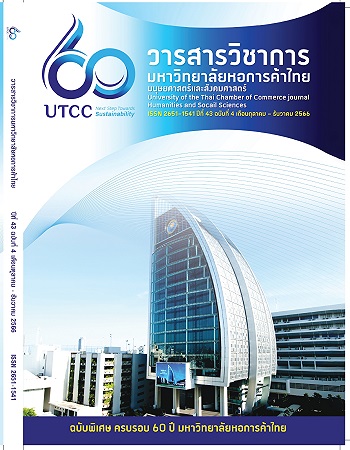Distorted financial behaviors resulting from behavioral decision-making biases.
Main Article Content
Abstract
To study the psychological patterns of irrational decision-making affecting financial phenomena, focusing on the behavior of investors in the Thai stock market and how irrationality leads to distorted investment goals. The objective is to present knowledge and information that helps readers understand cognitive biases and behaviors as obstacles to sound decision-making. Furthermore, it presents the concept of Noise, disturbances arising from within oneself and external environmental factors. This encourages individuals to pause and contemplate before making certain decisions or even ponder rational and trustworthy principles. The author has synthesized research, drawing from both experimental psychology and behavioral economics, focusing on the works of Professor Daniel Kahneman and various other researchers. This research has compiled instances of financial phenomena related to the theory of prospect theory, which has evolved from the utility theory, a fundamental concept in economics. Notably, the research findings underline that "people tend to feel the impact of losses more strongly than gains, up to twice as much." It further explores the concept of "loss aversion or the fear of regret". The writer perceives that biases in financial decision-making are driven by a"fear-based bias" and a bold front led by greed but harboring underlying fears. These factors lead to various financial phenomena, such as mental accounting. Therefore, avoiding errors benefits emotional control and makes the most “Valid” and “Reliability” decisions possible.
Article Details

This work is licensed under a Creative Commons Attribution-NonCommercial-NoDerivatives 4.0 International License.
ลิขสิทธิ์ของบทความ
ผลงานที่ได้รับการตีพิมพ์ถือเป็นลิขสิทธิ์ของมหาวิทยาลัยหอการค้าไทย ห้ามมิให้นำเนื้อหา ทัศนะ หรือข้อคิดเห็นใด ๆ ของผลงานไปทำซ้ำ ดัดแปลง หรือเผยแพร่ ไม่ว่าทั้งหมดหรือบางส่วนโดยไม่ได้รับอนุญาตเป็นลายลักษณ์อักษรจากมหาวิทยาลัยหอการค้าไทยก่อน
References
คณิสร์ แสงโชติ, รุ่งเกียรติ รัตนบานชื่น, และ วรประภา นาควัชระ. (2564). Digital assets in Thailand: Insights from transaction-level exchange data. ใน SEC Capital Market Symposium 2021. สืบค้นจาก https://www.sec.or.th/TH/Documents/Seminars/SECSymposium2021-02.pdf
ณัฐวุฒิ เจนวิทยาโรจน์. (2563). การเงินเชิงพฤติกรรม (Behavioral finance). กรุงเทพฯ: จุฬาลงกรณ์มหาวิทยาลัย.
พระพรหมคุณาภรณ์ (ป.อ.ปยุตโต). (2546). พจนานุกรมพุทธศาสตร์ ฉบับประมวลธรรม (พิมพ์ครั้งที่ 12). กรุงเทพฯ: โรงพิมพ์มหาจุฬาลงกรณราชวิทยาลัย.
วัลลภ คุ้มประดิษฐ์, และ ขวัญ เพชรสว่าง. (2560). บทบาทของเศรษฐศาสตร์พฤติกรรมต่อแบบจำลองทางเศรษฐศาสตร์มหภาค. ใน รายงานสื่บเนื่องจากการประชุมวิชาการระดับชาติสาขาเศรษฐศาสตร์ “อนาคตเศรษฐกิจไทยปี 61 รอดหรือซึมยาว” (น. 150-164). กรุงเทพฯ: มหาวิทยาลัยรามคำแหง.
ศรุติ โชติเสรีวิทย์. (2564). Investor mindset รู้ทันอารมณ์ สร้างกำไรด้วยเหตุผล. กรุงเทพฯ: ซีเอ็ดยูเคชั่น.
Bandura, A. (1977). Self-efficacy: Toward a unifying theory of behavior change. Psychological Review, 84(2), 191-215. doi: 10.1037/0033-295X.84.2.191
Bari, A. F., Yunanto, A., & Shaferi, I. (2020). The Role of financial self-efficacy in moderating relationships financial literacy and financial management behavior. International Sustainable Competitiveness Advantage, 10(1), 51-60. Retrieved from http://www.jp.feb.unsoed.ac.id/index.php/sca- 1/article/viewFile/1870/1745
Benartzi, S., & Thaler, R. H. (1995). Myopic loss aversion and the equity premium puzzle. The Quarterly Journal of Economics, 110(1), 73-92.
Carmon, Z., & Ariely, D. (2000). Focusing on the forgone: How value can appear so different to buyers and sellers. Journal of Consumer Research, 27(3), 360–370. doi: 10.1086/317590
Vesely, C. K., Brown, E. L., Mehta, S., & Horner, C. G. (2022). Staying afloat’: A mixed methods study of the financial and psychological well-being of early childhood educators. Early Childhood Education Journal. doi: 10.1007/s10643-022-01429-9
Coval, J. D., & Shumway, T. (2005). Do behavioral biases affect prices? Journal of Finance, 60(1), 1-34. doi: 10.1111/j.1540-6261.2005.00723.x
Grinblatt, M., & Keloharju, M. (2001). What makes investors trade? The Journal of Finance, 56(2), 589-616. Retrieved from https://www.jstor.org/stable/222575
Kahneman, D., Knetsch, J. L., & Thaler, R. H. (1990). Experimental tests of the endowment effect and the coase theorem. Journal of Political Economy, 98(6), 1325–1348. Retrieved from http://www.jstor.org/stable/2937761
Kahneman, D. (2012). Thinking, fast and slow. London: Penguin Books.
Kahneman, D., & Tversky, A. (1979). Prospect theory: An analysis of decision under risk. Econometrica, 47(2), 263-291. doi: 10.2307/1914185
Kahneman, D., Sibony, O., & Sunstein, C., (2021). Noise: A flaw in human judgment. London: William Collins.
Kempson, E., Finney, A., & Poppe, C. (2017). Financial well-being: A conceptual model and preliminary analysis. (Project Note no.3-2017). Retrieved from https://www.researchgate.net/publication/318852257
Mahendru, M., Sharma, G. D., & Hawkins, M. (2020). Toward a new conceptualization of financial well-being. Journal of Public Affairs. doi: 10.1002/PA.2505
Novemsky, N., & Kahneman, D. (2005). The boundaries of loss aversion. Journal of Marketing Research, 42(2), 119-128. doi: 10.1509/jmkr.42.2.119.62292
Odean, T. (1998). Are investors reluctant to realize their losses? The Journal of Finance, 53(5), 1775-1798. doi: 10.1111/0022-1082.00072
Shefrin, H., & Statman, M. (1985). The disposition to sell winners too early and ride losers too long: Theory and evidence. The Journal of Finance, 40(3), 777-790. doi: 10.2307/2327802
Sokol-Hessner, P., Hsu, M., Curley, N. G., Delgado, M. R., Camerer, C. F., & Phelps, E. A. (2009). Thinking like a trader selectively reduces individuals' loss aversion. Proceedings of the National Academy of Sciences, 106(13), 5035-5040. doi: 10.1073/pnas.0806761106
Tenney, J. A., & Kalenkoski, C. M. (2019). Financial ratios and financial satisfaction: Exploring associations between objective and subjective measures of financial Well-being among older Americans. Journal of Financial Counseling and Planning, 30(2), 231-343. Retrieved from https://eric.ed.gov/?id=EJ1241055
Thaler, R. H. (2015). Misbehaving: The making of behavioral economics. Retrieved from https://yourmoneyoryourlife.com/book-summary/
Tversky, A., & Kahneman, D. (1986). Rational choice and the framing of decisions. The Journal of Business, 59(4), 251-278. doi: 10.1086/296365
Younas, W., Javed, T., Kalimuthu, K. R., Farooq, M., Khalil-ur-Rehman, F., & Raju, V. (2019). Impact of self-control, financial literacy and financial behavior on financial well-being. The Journal of Social Sciences Research, 5(1), 211-218. Retrieved from https://arpgweb.com/pdf-files/jssr5(1) 211-218.pdf


